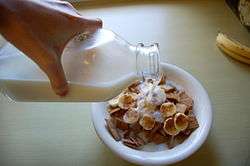Skimmed milk
Skimmed milk (British English), or skim milk (American English), is made when all the milkfat is removed from whole milk.[1] It tends to contain around 0.1% fat.[2]

Background
Historically, skimmed milk was used for fattening pigs, and was recommended as "not only the very best supplement for growing pigs, but is of almost equal value for fattening purposes" as it "furnishes a complete protein" and makes the feed "more palatable".[3]
Terminology
In the United Kingdom, milk is traditionally marketed and labelled as follows:
- Whole milk (around 3.5–4% fat) – litre bottles marketed in blue packaging are often found in shops.
- Semi-skimmed milk (around 1.8% fat) – Plastic liter bottles are marketed in green packaging.
- Skimmed milk (around 0.1% fat) – Plastic liter bottles are marketed in red packaging.
- Channel Island milk (around 5–5.5% fat)
Before the 1980s, milk was delivered on the doorsteps by a milkman in the early hours of the morning in glass pint bottles with the color printed foil lid indicating the milkfat content. Whole milk had plain silver foil, semi-skimmed milk had silver foil with red stripes and skimmed milk silver foil with a blue checker pattern.[2]
Additionally, some supermarkets in the UK now market milk as:
- 1% fat milk - Normally sold in purple or orange packaging.
In the United States, milk is marketed primarily by fat content and available in these varieties:
- Whole milk is 3.5% fat
- 2% Reduced-fat milk
- 1% Lowfat milk
- 0% Non-fat milk (also called skim milk or fat-free milk)
US milk producers also use a color-coding system to identify milk types, usually with the bottle cap or colored accents on the packaging. Whole milk is almost universally denoted by red, while 2% is most often colored royal blue. 1% and skim colors vary by region or dairy, with common colors for these lines being purple, green, yellow, pink, or light blue.
Health effects
Skimmed milk is sometimes consumed with the intention of reducing or limiting calorie consumption. It has been argued that the reduction in calories keeps the body further from satiety, causing it to ultimately seek out the missed calories, possibly from sources less beneficial.[4][5] The extent to which animal fat contributes to weight gain is also brought into question,[6][7] along with claims that skimmed milk is more beneficial to heart health since non-skimmed milk has a higher low-density lipoprotein content. Milkfat, however, affects only large, non-dense (Pattern A) LDL particles, which studies have shown to carry far less risk of coronary heart disease than small, dense (Pattern B) LDL particles.[8] Skimmed milk also contains almost no vitamin A.[9]
See also
References
- CFR - Code of Federal Regulations Title 21
- Ward, Andrew (23 May 2017). No Milk Today - The vanishing world of the milkman (1 ed.). London: Robinson. ISBN 1472138902.
- Oliver, A. W.; E. L. Potter (November 1930). "Fattening Pigs for Market" (PDF). Agricultural Experiment Station Bulletin (269): 14. Retrieved 21 November 2012.
- Alexandra Sifferlin (July 3, 2013). "Skim Milk is Healthier than Whole Milk, Right? Maybe Not". Time.
- The Real Food Guide Is Skim Milk Good For You? http://therealfoodguide.com/is-skim-milk-good-for-you/
- Enig, Mary, PhD. The truth about saturated fats.
- Ravnskov U, Allen C, Atrens D, et al. (February 2002). "Studies of dietary fat and heart disease". Science. 295 (5559): 1464–6. doi:10.1126/science.295.5559.1464c. PMID 11859893.
- Paul John Scott (May 2011). "Is Skim Milk Making You Fat?". Details.
- Christine Gallary. "How Is Skim Milk Made?". Section Skim Milk Additives. Retrieved 24 May 2019.